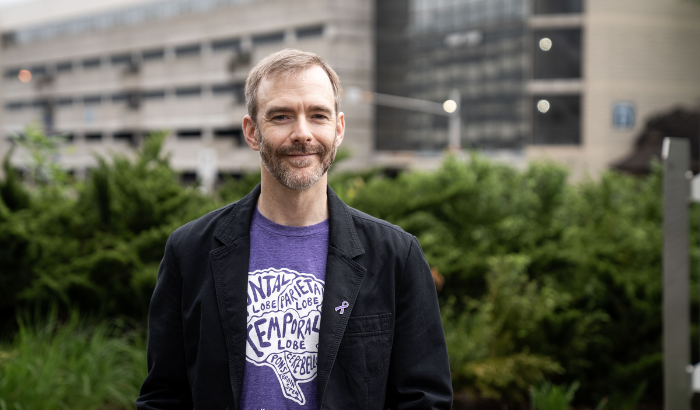
I’ve been dealing with epilepsy for nearly a decade. It started with strange sensations that occasionally followed stressful moments. I would suddenly overheat and have a funny feeling in my stomach or chest. I learned to sit down, close my eyes, breathe and wait a minute for it to pass. I didn’t know it then, but these were focal seizures.
In 2017, I had my first tonic-clonic seizure. It happened in my sleep while I was visiting my parents. I woke up confused with a severe headache. Later that same morning, I had two more seizures back-to-back. Thankfully, my parents were there and called 911. I regained consciousness in the back of an ambulance on my way to the hospital.
Two years later, I had another tonic-clonic seizure and was prescribed medication. It might have helped slightly, but the seizures continued. Around this time, I also joined Epilepsy South Central Ontario’s support group. I learned so much and greatly appreciated the support and understanding of the organizers and members.
Eventually, I was referred to the epilepsy team at University Hospital in London and Dr. Jorge Burneo, co-director of the Epilepsy Program, took on my case. At my first appointment, I felt clearly understood in a way I hadn’t before. I was filled with hope and that was just the beginning.
I stayed in the Epilepsy Monitoring Unit (EMU) three different times, for nine weeks in total. The EMU is where an amazing team of doctors, nurses and specialists closely monitor patients and track brain activity in hopes of capturing a seizure. For the first time, you hope to have one—and knowing you’re surrounded by the experts makes that easier. Mine only occurred every few months, so they were harder to catch. But eventually, it happened.
That led to a Stereoelectroencephalography (SEEG) procedure—13 electrodes implanted up to 10 centimetres deep into my brain—to help locate the seizure’s starting point. I experienced 11 seizures over two days, four of which were tonic clonics. I felt awful, but also happy it had finally happened and was recorded. The team discovered where my seizures started and that they were spreading through my insula. Therefore, they used an electrode inserted into that area and performed a radiofrequency ablation. Something very interesting—and literally mind-blowing—for somebody who studied electronics. It wasn’t expected to stop my seizures entirely, but it could reduce their frequency and severity. For the first time, I no longer lost my sense of taste and smell after a seizure. A win!
During my follow-up, Dr. Jonathan Lau, my neurosurgeon, told me that based on what they saw, I was a candidate for a temporal lobectomy—a positive but terrifying possibility. But then he shared something incredible: there might be an alternative. A much less invasive procedure called LITT (Laser Interstitial Thermal Therapy), which carries much lower risks to memory and cognitive function. Highly preferable for somebody like me, who hadn’t experienced any memory or cognitive issues. Dr. Lau had learned and performed the surgery while working in the U.S. and was working to bring it to London. I would be one of the first people in Canada to have this procedure and the first person to have it done in London. Canadians are so fortunate to have access to medication and traditional surgeries, but being offered a new procedure like this was hard to believe.
Five days before my surgery, Dr. Lau and I spoke again while he was finalizing plans for the surgery. He asked about my life, my interests—what mattered most to me. I told him I love cycling and being active and hoped the surgery wouldn’t affect my balance or vision. He understood completely.
On the day of my LITT surgery, my sister, my girlfriend and I arrived at the hospital at 6 a.m. My parents arrived a little later. The procedure took longer than expected, about 8 hours, but Dr. Lau let them know everything had gone well. Just two days later, I felt like one of the luckiest people in the world and I was ready to go home.
Today, I’m feeling the best I have in years. I’ve now gone six months without a seizure. My journey may not be over, and there are still unknowns ahead, but I’m staying positive.
I can’t fully explain the level of admiration and gratitude I have for the neurological doctors in London. They are a different kind of human. Not just brilliant, incredibly knowledgeable and dedicated, but deeply compassionate. I think I may have become a better person just by spending time with them.
I feel unbelievably lucky to be one of Canada’s first recipients of this surgery. So many talented people came together to make this happen, including a collaboration with neuroradiology and neuroanaesthesia. I later learned a generous donor made it possible to bring this procedure to London by funding the equipment and setup. That act of kindness, from someone I may never meet, gave me a chance at a better life. It's shocking in the best way and gives me hope for the future of humanity.